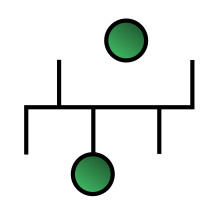Network topology guide for IoT
A network topology is how computers, printers and other devices are connected, and describes the layout of wires, devices and routing paths on a network. When referring to topology through the lens of IoT, it is how sensors, actuators and gateways communicate with one another. There are a number of common topologies, point to point, bus, ring, star and mesh., some of which are better suited for the internet of things than others:
Point-to-Point Network

A point-to-point network establishes a direct connection between two network nodes, according to O’Reilly’s Radar. Communication can take place only between these two nodes, or devices. An example of this type of network is a Bluetooth link between a cell phone and an ear piece. The advantages of point-to-point networking are its simplicity and low cost. The primary limitations spring from the one-to-one relationship that exists between two devices; the network cannot scale beyond these two nodes, therefore it is not a widely used topology for industrial IoT.
Bus
Features of Bus Topology
- It transmits data only in one direction.
- Every device is connected to a single cable
Advantages of Bus Topology
- It is cost effective.
- Used in small networks.
- It is easy to understand.
- Easy to expand joining two cables together.
Disadvantages include:
- Cables fails then whole network fails.
- If network traffic is heavy or nodes are more the performance of the network decreases.
- Cable has a limited length.
- It is slower than the ring topology.
Ring
A ring topology is a bus topology in a closed loop. Data travels around the ring in one direction. When one node sends data to another, the data passes through each intermediate node on the ring until it reaches its destination. The intermediate nodes repeat (retransmit) the data to keep the signal strong. Every node is a peer; there is no hierarchical relationship of clients and servers. If one node is unable to retransmit data, it severs communication between the nodes before and after it in the bus.
Star
In local area networks with a star topology, each network host is connected to a central hub with a point-to-point connection, with every computer indirectly connected to every other node with the help of the hub. The switch is the server and the peripherals are the clients. The network does not necessarily have to resemble a star to be classified as a star network, but all of the nodes on the network must be connected to one central device. All traffic that traverses the network passes through the central hub.
There are a few important advantages to a star topology, which has become to most commonly used topology, according to O’Reilly. First, the performance of the network is consistent, predictable and fast (low latency and high throughput). In a star network a data packet typically only travels one hop to reach its destination (if traveling between the hub and a sensor) or at most two hops (if traveling between two sensors), yielding a low and predicable network latency.
Second, there is high overall network reliability due to the ease with which faults and devices can be isolated. Each device utilizes its own, single link to the hub. This makes the isolation of individual devices straightforward and makes it easy to detect faults and to remove failing network components.
The disadvantages of this network type are similar to the point-to-point network. The range is limited to the transmission range of a single device. Additionally, there is no ability to route around RF obstacles should there be a network interference or interruption.
Mesh

A mesh network consists of three types of nodes:
- A gateway node as in a star network, provided so data can reach the outside world
- Simple sensors nodes
- Sensor/router nodes, which are sensor nodes with repeater/routing capability
Sensor/router nodes must not only capture and disseminate their own data, but also serve as relays for other nodes, according to O’Reilly.
Mesh network nodes are deployed such that every node is within transmission range of at least one other sensor/router node. Data packets pass through multiple sensor/routers nodes to reach the gateway node.
The primary disadvantage is that mesh networks are, by their nature, more complex than point-to-point or star network topologies. A sight survey is typically done followed by installation and commissioning of the network. Also, there is higher network latency in mesh networked due to multiple networks hops typical from the sensor to gateway.
Mesh is a growing network topology commonly found in IoT deployments, some of its advantages include:
- Data can be transmitted from different devices simultaneously. This topology can withstand high traffic.
- Even if one of the components fails there is always an alternative present. So data transfer doesn’t get affected.
- Expansion and modification in topology can be done without disrupting other nodes.



